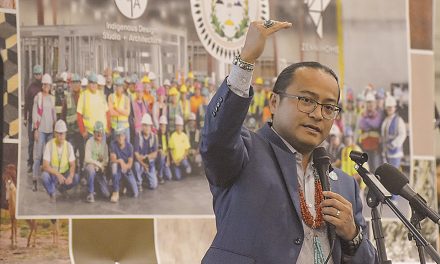
50 years ago: Nakai wins support NAC members
In some ways, Sam Billison was the Donald Trump of his time as he tried to unseat Raymond Nakai as chairman of the Navajo Nation.
For the past three months 50 years ago, Billison, who lost to Nakai in the last election, had been accusing Nakai of lying to the Navajo people about how much progress the tribe had made under his leadership.
He had not, however, begun calling him “Lying Raymond Nakai” as Trump has done with Hillary Clinton. But almost daily in his speeches he took off on Nakai and accused him of all sorts of unethical and possibly even illegal actions to get the vote of every tribal member.
His latest claim 50 years ago this week was that Nakai was going around to chapters and telling ranchers that they could have as many livestock as they want and they didn’t have to worry about a grazing permit.
“Many Navajos in District Four have taken this to be true,” said Billison, “and have indicated that they are thinking of voting for Nakai.”
“Nakai is claiming,” said Billison, “he has special permission from the President and Vice President of the United States to allow Navajo ranchers to ignore the BIA’s attempt to shut down on tribal grazing.”
Billison said that Nakai was not telling the people that in his proposal to create a tribal constitution, he planned to have a provision in it that would require enforcement of current BIA grazing regulations that limit how many sheep and cattle each Navajo family could have.
Nakai, of course, denied everything that Billison said, saying he has told no one they can have as many sheep and cattle as they want. And as for the constitution issue, he said he had left a copy of his proposed constitution at every chapter house and if they want to see if he has a clause in there about livestock, they are free to go to their chapter and look it over.
In other news, Navajo officials were saying that the newest problem among young people on the reservation was sniffing paint or glue to get a high.
Every major community on the reservation was trying to find a solution to the problem. Trading posts and stores on the reservation were saying you had to be 21 years of age with proof, if you wanted to purchase paint or glue.
But it appeared that all they had to do was go into Gallup where certain shop owners had made it obvious how easy it is to buy things off the reservation.
High school and junior high principals on the reservation stated they had found students hiding out in bathrooms or closets to be able to sniff the glue or paint at school. It was a real problem back then.
Reverting back to tribal politics and elections, everyone knows today that Nakai’s victory in the 1966 election and his ability to make it through the primary during the ’70s was due largely to one demographic of the Navajo population – members of the Native American Church.
Nakai was a major supporter of the NAC’s right to use peyote in their religious ceremonies and he lobbied Congress to get a law passed that gave federal protection to this right.
Nakai knew back in 1966 that it was his only chance of winning the support from NAC members so he must have been a little worried when the Navajo Times printed an interview with Frank Takes Gun, the president of the NAC who told the Times that the NAC “is to taking part in the Navajo election.”
By this time, the NAC membership on the Navajo Reservation included between 70 and 80 percent of the adult population and possibly more than 95 percent of the voting population.
“I don’t think the peyote group as such should take any part in the Navajo election,” Takes Gun said, adding that the leadership of the NAC was too busy to get involved in tribal politics.
Luckily for Nakai, Takes Gun was not speaking for the Navajo segment of the NAC who was at that very moment, during his interview, doing everything they could to get Nakai elected.
And finally, a talk force set up to look at the feasibility of creating the Navajo Indian Irrigation Project released their study on the idea.
The task force urged that the project be implemented as soon as possible because it would have a significant economic impact on the reservation.
The study predicted that with salaries and spending, it would have an annual impact of some $50 million on the economic development of the Shiprock-Farmington region.
The study was done in the hopes that the project could get underway no later than 1967 and be completed by 1978 at a cost of about $150 million to bring water to 110,000 acres of land south of Farmington
That didn’t happen.
Instead, the project began in 1972 and it still needs about 35,000 acres to be completed and the cost so far has topped $500 million.
To read the full article, pick up your copy of the Navajo Times at your nearest newsstand Thursday mornings!
Are you a digital subscriber? Read the most recent three weeks of stories by logging in to your online account.








 Highway 264,
Highway 264, I-40, WB @ Winslow
I-40, WB @ Winslow